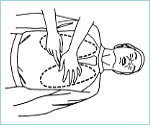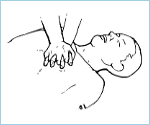COMPRESSIONS When performing chest compressions, proper hand placement is very important. To locate the correct hand position place two fingers at the sternum (the spot where the lower ribs meet) then put the heel of your other hand next to your fingers (Figure 1). Place one hand on top of the other and interlace the fingers (Figure 2). Lock your elbows and using your body's weight, compress the victim’s chest. The depth of compressions should be approximately 1½ to 2 inches - remember: 2 hands, 2 inches (Figure 3). If you feel or hear slight cracking sound, you may be pressing too hard. Do not become alarmed and do not stop your rescue efforts! Damaged cartilage or cracked ribs are far less serious then a lost life. Simply apply less pressure as you continue compressions. Count aloud as you compress 30 times at the rate of about 3 compressions for every 2 seconds. Finish the cycle by giving the victim 2 breaths. This process should be performed four times - 30 compressions and 2 breaths - after which remember to check the victim's carotid artery for pulse and any signs of consciousness. If there is no pulse, continue performing 30 compressions/2 breaths, checking for pulse after every 4 cycles until help arrives.
|
| |
| If you feel a pulse (i.e. the victim's heart is beating) but the victim is still not breathing, rescue breaths should be administered, one rescue breath every five seconds (remember to pinch the nose to prevent air from escaping). After the first rescue breath, count five seconds and if the victim does not take a breath on his own, give another rescue breath. Let's review | ||
14.11.07
C P R ADULT
Subscribe to:
Post Comments (Atom)







No comments:
Post a Comment